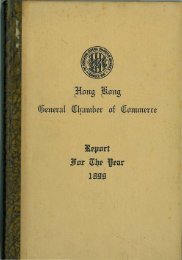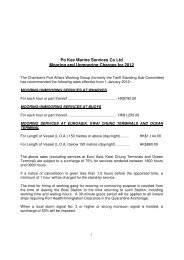æ¥é·è¯å°è¨ª - The Hong Kong General Chamber of Commerce
æ¥é·è¯å°è¨ª - The Hong Kong General Chamber of Commerce
æ¥é·è¯å°è¨ª - The Hong Kong General Chamber of Commerce
You also want an ePaper? Increase the reach of your titles
YUMPU automatically turns print PDFs into web optimized ePapers that Google loves.
Chewing the FatAmerica (sort <strong>of</strong>) Votes<strong>The</strong> United States will vote on November 6 this year,to choose the president, all 435 congressionalrepresentatives and 33 <strong>of</strong> the 100 senators. However,while the congressional and senate elections will(largely) be decided on that day, the actual presidentialelection will be held December 17.That is the first day when each <strong>of</strong> the states’ electoralcollege delegates meet to cast their votes. <strong>The</strong> resultsmust be delivered to the President <strong>of</strong> the Senate andother designated <strong>of</strong>ficials by December 26. Under theconstitution, no person may be elected president (or,vice president) by way <strong>of</strong> a direct popular vote. It’s muchtoo important, and so hand-picked delegates arecharged with delivering each state’s votes to Washington.Every four years, there’s much talk about changingthe system, but little real enthusiasm. More attention ispaid to where extra electoral (state) votes may be won,in what are called the swing or battleground states. Infact, there are 37 <strong>of</strong> them.In recent years, only eight states voted for thecandidate that eventually won the election, and theytogether comprise just 84 <strong>of</strong> the 538 electoral collegevotes, or 15.6%. A further 50 votes (9.3%) are historicallysafe for Republicans and 32 (5.9%) are highly likely tovote for the Democrats.Electoral votes are allocated according to the number<strong>of</strong> congress and senates seats, with each state havingtwo senators and a number <strong>of</strong> congressionalrepresentatives based on its population. So, each has aminimum <strong>of</strong> three votes, but California, the mostpopulous state, has 55. Other major players are Texas(38), New York (31), Florida (29), Illinois andPennsylvania (20 each) and Ohio (18).If a candidate won all <strong>of</strong> the big states, he (or she)would have just over 77% <strong>of</strong> the 270 votes needed towin. It is possible to win with just 11 states, but thediversity <strong>of</strong> the country suggests that strategy isn’t likelyto work out well.<strong>The</strong> Bulletin 工 商 月 刊 September 2012 31
















